by Paul Gilster | Dec 9, 2015 | Exoplanetary Science |
If you were trying to identify the kind of star that should produce Earth-like planets, you’d think the task would be straightforward. Our theories of planet formation focus on a circumstellar disk around a young star out of which planets form, and we’ve already gathered evidence that gas giant worlds are more likely to form around stars that are rich in iron. Since rocky planets are rich in iron and silicon, doesn’t this mean their stars should be rich in metallic elements?
New work out of the Carnegie Institution for Science suggests that the answer is surprisingly complex. As presented by Johanna Teske at the Extreme Solar Systems III meeting in Hawaii, the team’s work has revealed that smaller planets do not require high iron content in their parent stars. In fact, looking at the abundance of 19 different elements in seven stars orbited by at least one rocky planet (these are drawn from the Kepler catalog), the team finds that rocky worlds do not preferentially form around stars rich in metallic elements like iron and silicon.
The data were taken as part of the Kepler Follow-up Observing Program and supplemented by independent observations using the 10-meter Keck telescope and the HIRES echelle spectrometer. From the paper:
The metallicities of the seven stars range from [Fe/H] = ?0.30 to +0.15, further demonstrating that small planets form around stars with both low and high metallicities… The abundances of 15 elements are compared to those of a Galactic disk population that includes stars with and without known planets. The abundances of the Kepler planet host stars fall along the Galactic trends, suggesting that stars with small planets have compositions that are typical of the Galactic disk.
Stars with small planets, then, are nothing exceptional in terms of their metallicity. This implies they are common throughout the galaxy. The paper goes on:
Moreover, comparing the abundance distributions of the Kepler planet host stars to a sample of stars with no detected planets, a sample of Neptune- and super-Earth-size planet hosts, and a sample of Jupiter-type giant planet hosts, reveals that the former three – Kepler host stars, stars without known planets, and the Neptune and super-Earth-size planet hosts – may have similar compositions, whereas the Kepler host stars appear to have compositions that are less enhanced than those of Jupiter-type planet hosts.
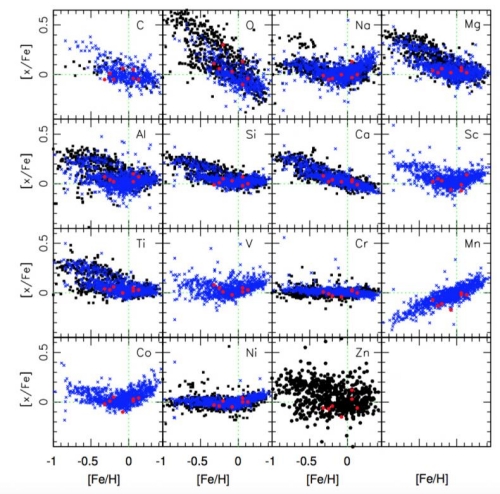
Image: This figure from the paper shows the abundance of different elements in stars versus their abundances of iron. In each square, you can see a plot of the abundance of one element (represented by [x/Fe]) against the abundance of iron (represented by [Fe/H]). Each red dot, black square, or blue X represents a star. The red dots are the small planet-hosting stars studied in this new work. You can see how they do not stand out from the rest of the stars, which were studied in other publications, some of which host planets and some of which have no known planets. The green dashed lines show these values for our Sun. Credit: NASA Ames/JPL-Caltech/Tim Pyle.
Small, rocky planets appear to form around stars with a wide range of elements, whereas gas giants are more likely around stars rich in iron. Teske adds in this Carnegie news release that the results are exciting “…because they mean that small planets are very common and chemically diverse.” What we don’t yet know is whether the planet formation process depletes stars of some of the elements that become concentrated in the planets. None of the seven stars the team studied show a depletion signature, but if subsequent work does uncover such a trend, then looking for stars with specific chemical depletions could be a useful planet-hunting tool.
Does the architecture of a solar system play a role in these trends? With the exception of two planets, the planets of all the stars investigated have semimajor axes smaller than Mercury’s. As the paper notes, the small sample size here limits the statistical significance of the results, so the obvious next step is generating a larger sample of stars with small planets and performing abundance analyses on this set. We’re fortunate that the Kepler mission has identified numerous small planets whose host stars can now be subjected to this kind of study.
The paper is Schuler et al., “Detailed Abundances of Stars with Small Planets Discovered by Kepler I: The First Sample,” accepted for publication in The Astrophysical Journal (preprint).

by Paul Gilster | Dec 8, 2015 | Culture and Society |
Back in 2012 I reported on Peter Garretson’s What Our Civilization Needs is a Billion Year Plan, an essay advocating a robust human expansion to the stars. Lt. Col. Garretson lives and breathes futuristic issues. A transformational strategist for the US Air Force, he has served as an airpower strategist and strategic policy advisor to the Chief of Staff of the Air Force on his Strategic Studies Group, the Chief of Irregular Warfare Strategy, Plans and Policy, and spent four years as the Chief of Future Technology for HQ USAF Strategic Planning. He is currently an Instructor of Joint Warfare at Air Command and Staff College and the lead for Space Horizons, Air University’s endeavor to “re-imagine spacepower in the age of asteroid mining.” A long-time space advocate, he has written widely on issues ranging from planetary defense to solar power; you can follow his work at his website: http://www.petergarretson.com/. In today’s open letter to Centauri Dreams, he lays down a first draft for a bill aimed at energizing NASA’s role in developing the technologies needed for starflight.
by Peter A. Garretson

Sooner or later we are going to discover an Earth-like exoplanet, and when we do, we are going to want to go there. The 100 Year Starship, Icarus Interstellar, Tennessee Valley Interstellar Workshop, Initiative for Interstellar Studies, Tau Zero and Centauri Dreams are all catalyzing terrific work that forwards general spacefaring and space industrial capabilities. And like NASA’s BPP more low-dollar work could lead to great NIAC-like thinking and advances. Those of us who already know that this should be our direction should have ready legislation to move forward. Here is an initial draft of what might be in such a bill:
Gene Roddenberry Memorial America Starfaring / Starship bill.
It is the will of the Congress that America should become a star-faring civilization, bringing new life to uninhabited worlds, ensuring our continuity, security and prosperity for our posterity. It is the will of the American people for America to develop the capability to “seek out new life and new civilizations, to boldly go where no one has gone before.”
And if it is the dream of Congress, by America’s Quadricentennial (2176) America will have reached another star.
To that end, NASA, the DOE, and DoD are authorized and encouraged, in concert, and in concert with private industry and academia to:
- Develop technologies and capabilities to enable interstellar probes
- Develop propulsion and life support capabilities that could enable a manned mission in a single human lifetime
- Develop off-Earth industrial capability to construct and launch such missions through space resource utilization (space mining and space power)
- Enable thriving off-Earth communities and a space economy that could support the expense of such a mission
NASA is directed to:
- Sponsor a Conference every two years to review the most exciting and profitable destinations and present visions and ideas to the public
- Review and present to the public progress and conceptual designs for interstellar missions
- Present to Congress, every two years, the most exciting and profitable destinations beyond our heliopause, and progress in the necessary technology.
//Signed//
PETER A. GARRETSON, Lt Col, USAF
Air University Space Horizons Activity Lead

by Paul Gilster | Dec 7, 2015 | Outer Solar System |
I finally have a landscape to attach to Larry Niven’s classic “Wait It Out,” a tale of shipwreck on Pluto. The New Horizons imagery is giving us resolutions of 77-85 meters per pixel, so that we can, as this JHU/APL news release reminds us, see features less than half the size of a city block. The one below is the one that has me captivated because it reminds me of the Niven tale, in which a team of astronauts becomes stranded on Pluto’s surface, and the protagonist deliberately exposes himself to the vacuum to place himself into cryogenic storage.
A man can stay conscious for tens of seconds in vacuum. If I moved fast, I could get out of my suit in that time. Without that insulation to protect me, Pluto’s black night would suck warmth from my body in seconds. At 50° Absolute, I’d stay in frozen storage until one version or another of the Day of Resurrection.
And then this:
A superconductor is what I am. Sunlight raises the temperature too high, switching me off like a damned machine at every dawn. But at night my nervous system becomes a superconductor. Currents flow; thoughts flow; sensations flow. Sluggishly. The one hundred and fifty-three hours of Pluto’s rotation flash by in what feels like fifteen minutes. At that rate I can wait it out.
Niven wrote “Wait It Out” in 1968, published it in a science fiction convention program book, then in an anthology edited by Robert Silverberg, before its 1971 publication in All the Myriad Ways, perhaps my favorite of all the Niven short story collections. Ever since reading it, I’ve thought about what the frozen astronaut would see, described by Niven as a row of frozen mountains over which “the stars pour up in singletons and clusters and streamers…”
Now I can envision our protagonist on Sputnik Planum, on a relatively smooth block of nitrogen crustal ice looking out toward the al-Idrisi mountains. The images below were all made with New Horizons’ Long Range Reconnaissance Imager (LORRI) about fifteen minutes before the spacecraft’s closest approach to Pluto, at a range of 17,000 kilometers. We’re seeing the results of LORRI recording images every three seconds using unusually short exposures.
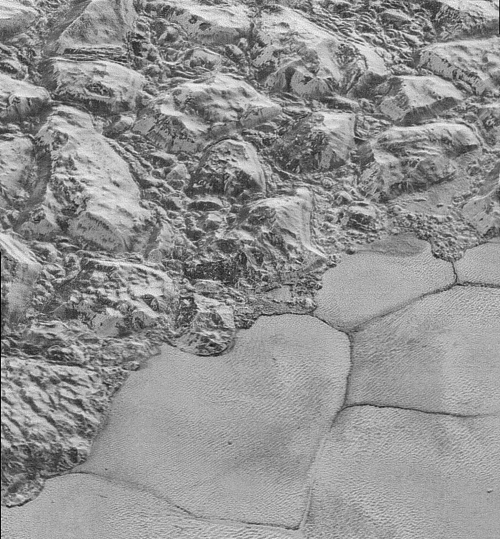
Image: In this highest-resolution image from NASA’s New Horizons spacecraft, great blocks of Pluto’s water-ice crust appear jammed together in the informally named al-Idrisi mountains. Some mountain sides appear coated in dark material, while other sides are bright. Several sheer faces appear to show crustal layering, perhaps related to the layers seen in some of Pluto’s crater walls. Other materials appear crushed between the mountains, as if these great blocks of water ice, some standing as much as 2.5 kilometers high, were jostled back and forth. The mountains end abruptly at the shoreline of the informally named Sputnik Planum, where the soft, nitrogen-rich ices of the plain form a nearly level surface, broken only by the fine trace work of striking, cellular boundaries and the textured surface of the plain’s ices (which is possibly related to sunlight-driven ice sublimation). This view is about 80 kilometers wide. Credit: NASA/Johns Hopkins University Applied Physics Laboratory/Southwest Research Institute.
The magnitude of New Horizons’ success is reflected in the quality of this and the images that follow below, which are about five times better than the best images of Triton we received from Voyager 2 back in 1989. And principal investigator Alan Stern has made the point that when we were first exploring Mars and Venus, it took decades to develop the ability to see with this level of detail. Our instrumentation has come a long way, and so has this one-shot flyby mission, which has demonstrated how much can be done even when an orbiter is not available.
As to that view that reminds me of the Niven tale, New Horizons team member John Spencer describes it well:
“The mountains bordering Sputnik Planum are absolutely stunning at this resolution. The new details revealed here, particularly the crumpled ridges in the rubbly material surrounding several of the mountains, reinforce our earlier impression that the mountains are huge ice blocks that have been jostled and tumbled and somehow transported to their present locations.”
Two other recently released images follow. With New Horizons now 167 million kilometers beyond Pluto and 5.2 billion kilometers from the Earth, all systems remain operational and we can expect still more imagery from this data set over the next few days.
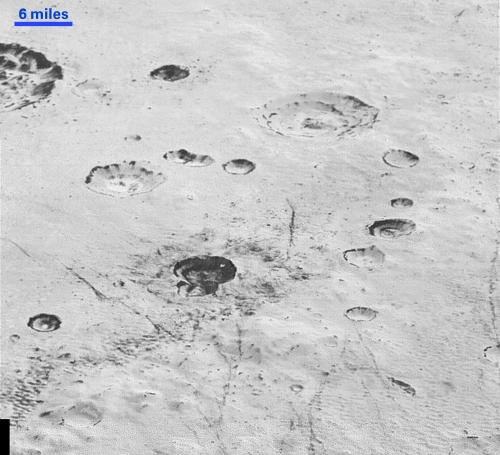
Image: Notice the layering in the interior walls of many craters (the large crater at upper right is a good example) – layers in geology usually mean an important change in composition or event but at the moment New Horizons team members do not know if they are seeing local, regional or global layering. The darker crater in the lower center is apparently younger than the others, because dark material ejected from within – its “ejecta blanket” – have not been erased and can still be made out. The origin of the many dark linear features trending roughly vertically in the bottom half of the image is under debate, but may be tectonic. Most of the craters seen here lie within the 250-kilometer-wide Burney Basin, whose outer rim or ring forms the line of hills or low mountains at bottom. The basin is informally named after Venetia Burney, the English schoolgirl who first proposed the name “Pluto” for the newly discovered planet in 1930. Credit: NASA/Johns Hopkins University Applied Physics Laboratory/Southwest Research Institute.
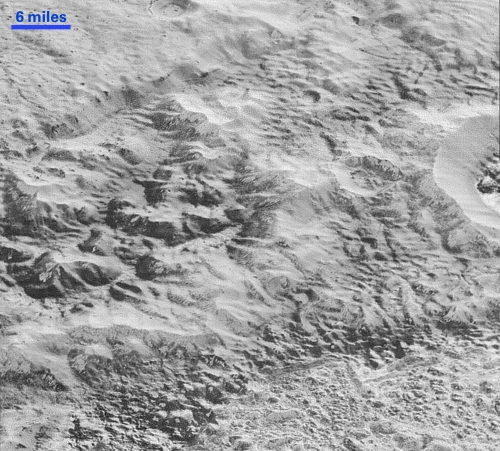
Image: This image shows how erosion and faulting has sculpted this portion of Pluto’s icy crust into rugged badlands. The prominent 2-kilometer-high cliff at the top, running from left to upper right, is part of a great canyon system that stretches for hundreds of kilometers across Pluto’s northern hemisphere. New Horizons team members think that the mountains in the middle are made of water ice, but have been modified by the movement of nitrogen or other exotic ice glaciers over long periods of time, resulting in a muted landscape of rounded peaks and intervening sets of short ridges. At the bottom of this 80-kilometer-wide image, the terrain transforms dramatically into a fractured and finely broken up floor at the northwest margin of the giant ice plain informally called Sputnik Planum. Credit: NASA/Johns Hopkins University Applied Physics Laboratory/Southwest Research Institute.

by Paul Gilster | Dec 4, 2015 | Deep Sky Astronomy & Telescopes |
A dedicated spacecraft just to investigate the Alpha Centauri system? I’ve been fascinated with the nearest stars since boyhood, so the ACEsat concept Ashley Baldwin writes about today would have my endorsement. But budgetary realities and practical mission planning might demand a larger instrument capable of studying more distant targets. Dr. Baldwin, a committed amateur astronomer, is consultant psychiatrist at the 5 Boroughs Partnership NHS Trust (Warrington, UK). His deep knowledge of telescope technologies has served us well in the past, and now takes us into the realm of mission planning beyond the James Webb Space Telescope.
by Ashley Baldwin

ACEsat is a revolutionary all silicon carbide, 45 cm telescope concept with a bespoke built in Phase Induced Amplitude Apodisation (PIAA) coronagraph designed to image planets (in five selected visible-wavelength bands from 400-700 nm) in the habitable zones of Alpha Centauri A and B. It was designed to take advantage of studies that show a 10-55% probability of a 0.5-2R Earth planet in these areas. Other objectives included determining exoplanet size, mass and orbit as well as imaging any “debris disk”.
The mission was conceived by a team from NASA Ames led by Ruslan Belikov and Eduardo Bendek, in conjunction with Northrop Grumman, and was recently unsuccessfully submitted for NASA Small Explorer funding (SMEX). Only circa $100 million for a lot of telescope, the design when compared with the ongoing WFIRST (Wide-Field Infrared Survey Telescope) mission highlights the critical issues of directly imaging exoplanets with coronagraph-based telescopes. These are small at present, but the science is central to the potentially large telescopes of the 2030s. As the 2020 Decadal NASA “roadmap” for the next decade approaches, the battle lines are being joined for what comes after JWST. Yes, that far ahead!
Fitting Alpha Centauri into the Roadmap

At present the various astrophysics subcommittees have got together with universities to make recommendations to the NASA Executive for consideration. In terms of telescopes, the main examples are a 10-12m UV, Visible and Near-Infrared “all rounder” telescope that is likely to be segmented like a big JWST and be fitted with high performance coronagraphs for exoplanet imaging (see below ). There is also a large, segmented Far-Infrared telescope like a direct descendent of JWST, an X-Ray telescope and a 4m “Habex” dedicated exoplanet telescope.
Image: Centauri A and B as captured by Cassini over the limb of Saturn. Credit: NASA/JPL.
Science definition groups are in the process of being formed to try and reach a consensus on what will be prioritised in the Decadal roadmap. All of these missions would be classed as “flagship” (multi-billion $), and if WFIRST does fly, as appears likely, the money for the 2020s will be spent before they arrive! This plan is thinking 15 years ahead. There is no guarantee that an exoplanet telescope will be selected, though interest in the field is burgeoning, with one third of papers submitted to journals last year on the topic. The presence of both a Far-Infrared telescope and an X-Ray telescope illustrates the influence some groups historically maintain. The two imaging missions are intertwined and illustrate the process of imaging exoplanets with internal occulters or “coronagraphs”.
The PIAA coronagraph, as usual, stands out in all domains barring average contrast reached. This device has a substantial heritage over the last decade in small exoplanet imaging concepts such as EXCEDE (Exoplanetary Circumstellar Environments and Disk Explorer), PECO (Pupil mapping Exoplanet Coronagraphic Observer) and most recently the Probe concept Exo-C, a smaller version of which ACEsat is based on. Simulations show how important “post processing” of the raw data received from the telescope is.
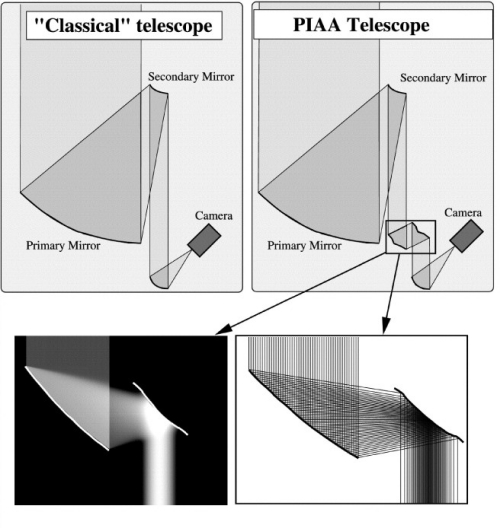
Image: An off axis telescope without and as ACEsat with a PIAA coronagraph. Credit: Wikimedia Commons.
Conventional methods will improve contrast by up to thirty times. This includes techniques that remove “speckles” or stray starlight within the telescope due to wavefront errors or mirror imperfections. “Angular differential imaging” removes these by rotating the image and subtracting it from the original non-rotated version. “Spectral differential imaging” takes advantage of subtle variations in the spectrum of reflected planet light. This will include the spectra of molecules in any atmosphere, which will be very different from back or foreground targets as well as exo-zodiacal light. Finally, when reflected off a planet, starlight tends to become more polarised, which differentiates it from the original starlight and background sources. Thus a polarimeter can separate out an exoplanetary signal. Ground-based telescopes used for exoplanet imaging, like the VLT, employ just such devices to run as part of an instrument package like SPHERE (Spectro-Polarimetric High-contrast Exoplanet REsearch) that also includes a coronagraph.
All of these methods are conventional and effective and, importantly, applied to the image after it has been taken or during the process of forming it. They are easy to do and don’t require multiple images. Compare this to the newest form of differential imaging, discussed below. These are ways of making the exoplanet stand out from the overall telescope field. That’s enough to take the telescope’s observations from “no image ” to “image”. The PIAA best contrast goes from just under 3×109 to 9×1011. In this case, that translates from seeing a large gas giant to seeing something Earth-sized. The post processing also takes some of the pressure of delivering contrast away from the coronagraph and its designers, too.

Image: Two habitable zones to work with in this close binary. What will we find around Centauri A and B?
How ACEsat Operates
ACEsat is a small, 45cm telescope, yet it can deliver contrasts down to 3×1011. How? Until recently there have been just two post processing techniques. The ACEsat team have cleverly created an additional technique called “Orbital differentiating imaging” (ODI). This uses an exoplanet’s orbit to identify it from the background “noise”. It is so potent that it is even resistant to exozodiacal light (dust from asteroids and comets that reflects light like planets, thus mimicking them — believed to be responsible for the “planet” seen shepherding the Fomalhaut protoplanetary disk) that can contaminate and ruin previous exoplanet imagery.
By way of comparison, ODI can improve contrast by a thousand times. The key is that to deliver ODI, one needs information on a good fraction of the exoplanet’s orbit. That’s why ACEsat had to take 2000 images of Alpha Centauri over a two year period, yet despite its size could deliver images AND spectroscopic characterisation. That approach requires a dedicated telescope, not the one year laid aside for WFIRST, though as can be seen, terrestrial planets could still be viewed — such is the potency of the PIAA versus other coronagraphs. The Hybrid Lyot coronagraph has been chosen for WFIRST so far as its average performance is better, and with limited time to justify inclusion, the coronagraph needs as many planets characterised as possible. Hence the list of known Exo-Jupiters that will dictate its use. Quantity over quality.
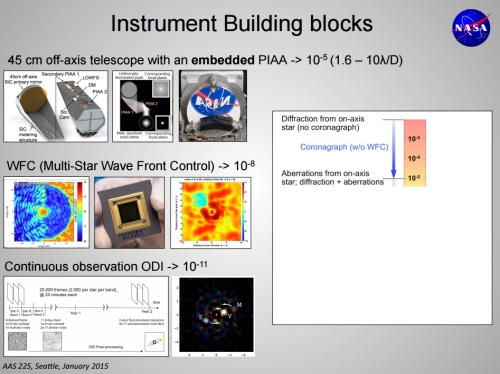
Image: From a presentation on ACEsat by Eduardo Bendek at AAS 2015 in Seattle, available online.
The other key feature of the PIAA is its “inner working angle” (IWA). This is the degree to which the parent starlight is compressed inwards as much as possible, concentrated by the PIAA, in order to create a dark disk around the star that will allow any exoplanets to stand out. The PIAA is the only coronagraph considered for WFIRST that has an IWA that would allow a planet in the habitable zone of a Sun-like star to be seen. The smaller the IWA the better. This also allows for smaller orbits, which of course require less time and images to determine, thus allowing ODI to come into play. The price for this precision is that the coronagraph is extremely sensitive to “jitter”, small unwanted movements caused by the steering reaction wheels, and thermal instabilities.
The WFIRST simulation data demonstrate how severe this can be and disruptive to successful exoplanet characterisation. It was because of thermal instabilities that silicon carbide was chosen as a construction material, as it is very stable to changes in temperature, defined by the “coefficient of thermal expansion”. Jitter is actively mitigated by the use of a “fast” tip/tilt mirror incorporated into the optical train that the coronagraph sits in, one that uses starlight rejected by the coronagraph to feed a computer that in turn controls the position of the mirror to correct any wavefront errors. Such is the importance of this part of the telescope that despite the presence of an on-board computer, “real time” modifications will still need to be made from the ground, all of which adds to the “operations costs” described later.
Wavefront errors arising from other sources are corrected in turn by an electromechanical, MEMS-deformable mirror (DM), also in the optical train and also feeding a guiding computer. The equivalent of active optics in a ground-based telescope. Imperfections in the telescope mirror can allow stray starlight in the firm of “speckles ” that can be removed this way.
Working with a Close Binary
With ACEsat, which is in the unusual situation of imaging a close binary system where light from one star will seep into planetary imaging of its neighbour, deformable mirrors managed by a “multi-star wavefront control” computer algorithm counteract this and in doing so open the door to imaging planets around the many binary systems close to the Solar System. All of these will reduce the telescope’s overall throughput, which demonstrates why it is so important not to throw away light in the coronagraph given there is so little to start with. Other conventional glass mirrors also possess such properties, but for a small telescope are prohibitively expensive and heavy. The initial ACEsat bid had the telescope in an “Earth trailing orbit”, drifting away at 0.2 AU per year but in a thermally stable, easy (cheap) orbit in direct contact with Earth. Traditionally such missions utilise the superior but more difficult to reach Earth/Sun Lagrange 2 point. Trade offs are a necessity when funds are low.
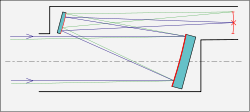
The other issue is the amount of light the coronagraph allows through to the all important spectrograph. ACEsat is an off-axis telescope in that its mirror is offset to focus its light to a point outside the telescope, so that there is no obstructive secondary mirror or coronagraph to waste precious incident light (up to 20% is obstructed in on-axis telescopes). The coronagraph thus runs down the side of the telescope and is actually embedded into it, which is possible with a smaller telescope with a less complicated mirror arrangement in its coronagraph, and embedding helps significantly reduce the damaging “jitter” described above.
Image: A simple illustration that illustrates the off-axis concept. Here the red line is the focal plane where spectrograph, imaging camera, polarimeter etc are located. Credit: Wikimedia Commons / Ashley Baldwin.
Inside the PIAA Coronagraph
The PIAA is the only coronagraph with near 100% throughput, thus allowing all light delivered by the telescope for characterisation in the spectrograph at the end of the “optical” train. The importance of this is that spectrographs unavoidably have considerably less than 100% throughput while some coronagraphs have only 20% throughput! A PIAA coronagraph in essence uses two sets of “aspheric” (curved at edges) mirrors to concentrate the Point Spread Function (PSF), or disk of light produced by a telescope when it images a point light source like a star. It removes the sharp diffraction rings that surround the central disk to create a dark area where reflected planetary light can be seen. In essence, the central starlight is slowed down whilst the extreme edge is allowed as normal, leaving a dark area around the edges.
A simple “stop” blocks off the Gaussian-like “peak” of starlight, creating a dark starlight-free zone around the PSF in which, with suitable contrast and light, an exoplanet image can be seen. The PIAA is unique amongst coronagraphs in allowing through most of the planet light, which is vital when one thinks just how faint this is. Up to ten billion times less than the star in the visible spectrum, though less as wavelengths increase into the infrared, which allows for lower imaging contrast but at the price of image resolution, which is derived from wavelength/telescope aperture.
ACEsat takes advantage of the PIAA design to actually embed it around the telescope secondary and tertiary mirrors, which feed the concentrated PSF starlight to an occulter at the first focal plane, where most of it is blocked and some is redirected to a computer that controls the deformable mirror “upstream” that then corrects any wavefront errors. This process helps create the dark area surrounding the central PSF described above, allowing planet light to pass unhindered through the optical train to the final focal point, and imaging via electron magnifying CCD (EMCCD) cooled to minus 85° C. This cooling prevents “dark current”, electrical current arising spontaneously within the pixels of the sensor array and causing them to activate in the absence of genuine photon stimulation.
The EMCCD sensor is now standard for visible imaging, with its individual pixels (1024×1024) releasing additional electrons when stimulated by a light photon in order to boost the final image/signal. The embedding of the PIAA around the telescope mirrors IWA unique design features that are only practical in smaller telescopes but do increase the telescope stability many fold. It is impossible to overstate just how important telescope stability is when imaging faint light sources light years away. Despite a “vibration source isolation system” that separates the telescope from its bus and its 23 fine-pointing reaction wheels, the transfer of some vibration or “jitter” is unavoidable, as is some degree of thermal instability, and this needs to be controlled to within 0.5 milli-arc seconds by tip/tilt mirror and related computer for a successful image to be formed.
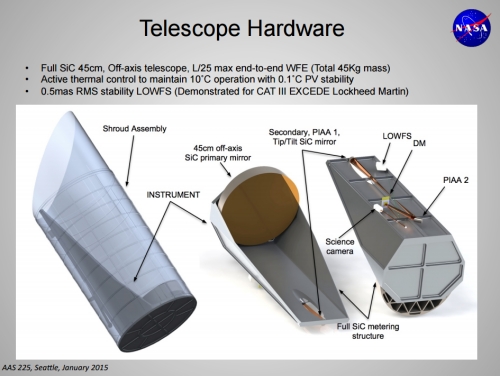
Image: ACEsat hardware, from Eduardo Bendek’s presentation at AAS 2015.
The PIAA’s small IWA, though helpful in allowing planets to be imaged as near to the stars as possible, also increases the telescope’s sensitivity to jitter. The larger and more sensitive the scope, the greater this sensitivity. ACEsat is ahead of its time because of its small size, allowing greater stability. This approach is so far only possible up to 1.5m and the main drawback is that, although the planets can be characterised in terms of mass and orbit, detailed spectroscopic analysis, looking for atmospheric constituents for instance, is not possible. The larger versions simply allowing a wider radius of imaging. Even the 45 cm version of ACEsat was intended for an extended mission to image Sirius, Procyon and Altair, with the latter as far out as 16 light years. All of these are either genuine or visual binaries with a bright member, so fitting in well with ACEsat’s imaging strategy.
ACEsat clearly illustrates the incredible precision that would be needed on the kind of multi-metre aperture telescopes that would have the light gathering sensitivity to spectroscopically analyse exoplanets. What it does do, though, is introduce the new and potent orbital differentiating post-processing technique that could work just as well or indeed better with larger telescopes, whilst taking some of the contrast role off of the coronagraph. The need for prolonged imaging to obtain as much of an exoplanetary orbit as possible is evident, which requires dedication. ACEsat proposed observation periods run of up to 100 days at a time.
A Future for ACEsat?
There is clear synergy between ACEsat and WFIRST in that the ongoing research on the latter will improve the PIAA coronagraph further. The complex internal architecture of the National Reconnaissance Office (NRO) array that forms WFIRST is such that it effectively makes the telescope segmented, thus providing a comparison of a monolithic telescope versus the segmented design. If the hybrid Lyot remains the coronagraph of choice for WFIRST, should a revised version of ACEsat become reality then there will be opportunity to compare coronagraphs in the field and not just in the lab. The ACEsat design itself is a smaller version of the Exo-C Probe concept telescope that arose from NASA’s desire to look at exoplanet alternatives to WFIRST. As it is likely that any large space telescope of the future will be equipped with high performance coronagraphs, both WFIRST and ACEsat present perfect test beds.
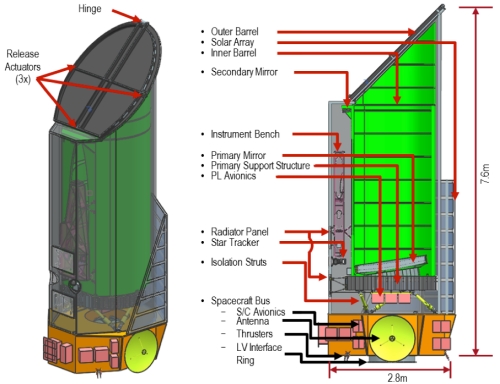
Image: The monolithic 1.5m off axis Exo-C telescope that is near identical to the biggest version of ACEsat. The only difference is it uses a Hybrid Lyot coronagraph instead of a PIAA and it isn’t embedded in the telescope wall. Otherwise, this is a good representation of a big ACEsat or indeed any unobstructed coronagraph exoplanet imager. Image credit: Exo-C Concept Development page / JPL.
ACEsat was unsuccessful for its SMEX bid. Its design is robust and its construction material, silicon carbide composite, which is used for the entire satellite, has an extensive and successful heritage in Europe. The mission objective was purely Alpha Centauri, so if nothing was discovered for any reason, then the funding is wasted as the telescope at just 45cm was bespoke for our nearest stellar neighbour. It will interesting to see what modifications any funding resubmission has. For one, it is likely to be larger to allow characterisation of more than one star system and not have “all its eggs in one basket”. The design can be extrapolated to at least a 1.5m aperture with eighty times the light gathering of the original ACEsat and more than three times the resolution. This should allow a planets as far out as thirty light years to be imaged over the extended period only a dedicated telescope can provide.
The question is just how much bigger the available funding would allow this telescope to become. The now familiar Dawn mission was cancelled/postponed on several occasions amidst a NASA funding crisis but subsequently reinstated when it’s manufacturers, Orbital Sciences Corporation, agreed to build it at “cost”, so confident were they in the ability of its innovative design to deliver. A decision that more than paid off with great science and publicity.

Image: Potential targets for an expanded ACEsat. Credit: ESO.
It’s worth mentioning that an 80m ground based ELT, based in optical viewing conditions on the Antarctic domes, could be expected to characterise 40 of the nearest Earth-like planets. An enhanced ACEsat of, say, 1.5m stands respectable comparison to this and illustrates the huge advantage of imaging above the atmosphere. And at a fraction of the cost.
The only question that leaves unanswered is, “how big”? The largest funding pool available for such missions is the Explorers programme of TESS fame. It is about $200 million with facility to top up with any savings made on using a smaller than expected launcher – a distinct possibility for a small telescope made from ultra light material. Silicon carbide is 5-10 times less heavy than conventional materials and equivalently cheaper. Capping mission time to, say, just two years is a gamble that releases funds from mission operations and systems engineering (running costs !) into the telescope proper, on the assumption that even in this shorter time enough high quality science will be delivered to justify a significant extension. Consumables (fuel etc) reflect this by being far more than is necessary for the primary mission. If sensitive spectrographs like ESPRESSO come on line in the next two years, their precision work will provide a list of nearby targets to reduce exoplanet search times within previous mission time. The TESS spacecraft bus has a life expectancy of up to seven years or more despite a two year primary mission.
There will be no additional funds for exoplanet imaging next decade. If “ACEsat plus” is approved, that will be two exoplanet imaging missions to supplement PLATO and the ELTs, preparing hopefully for the big telescopes of the next decade. It may not be the USS Enterprise, but an enlarged ACEsat telescope would enable man to boldly go where no man has been before. Unlike a manned spacecraft, its ingenious design and novel construction material, silicon carbide, will cost a small fraction of conventional telescopes and fit within pre-existing funding envelopes. Its coronagraph, sophisticated wavefront control and processing algorithms will allow imaging of our nearest stellar neighbours and open up a whole new investigation area in binary systems.
By far and away the most exciting goal is looking for planets in the habitable zone of the two sun analogues of the Alpha Centauri system. In doing so it will be years ahead of its time, dovetail with the small exoplanet technology demonstrator element of WFIRST and be the forerunner of the large telescopes to come. A tremendous achievement if Ames and Northrop Grumman can pull it off. Dawn of a new age?
We live in interesting times. Parlous financial circumstances have not stopped the eighteen month placement of a lunar UV telescope by a Chinese team, while India is launching an X-ray telescope. Things are moving forward fast. The question is, just how far are this US team prepared to go to achieve their visionary goal and maintain an obvious technological lead? Success could lead to the first habitable exoplanet or at least a terrestrial planet in a habitable zone, so the rewards are potentially huge, while the costs are low.
——-
Further Reading
“From Cosmic birth to living Earths: A visionary space telescope for UV-Optical-Near IR Astronomy”: AURA, 2015. http://www.hdstvision.org/report/
“How to directly image a habitable planet around Alpha Centauri with a 30-45cm telescope”: AAS Belikov et al., 2015. http://arxiv.org/abs/1510.02479
“Space mission and instrument design to image the habitable zone of Alpha Centauri”: Bendek et al 2015. http://adsabs.harvard.edu/abs/2015AAS…22531102B
“The orbital design of Alpha Centauri Exoplanet Satellite (ACEsat) Heliocentric orbit design: Interplanetary small satellite conference, Beyond LEO”: Weston et al 2015. http://digitalcommons.usu.edu/cgi/viewcontent.cgi?article=3228&context=smallsat
WFIRST-AFTA, STDT final report: Spergel et al 2013. http://wfirst.gsfc.nasa.gov/science/sdt_public/WFIRST-AFTA_SDT_Final_Report_Rev1_130523.pdf
“The search for habitable worlds 1: The viability of a star shade mission”: Turnbull et al, 2012. http://arxiv.org/abs/1204.6063
“Design study of an 8m monolithic mirror UV/Optical space telescope”: H Philip Stahl 2009. http://www.stsci.edu/institute/atlast/documents/stahl_8mDesign_SPIE2008.pdf
“WFIRST-AFTA Coronagraph instrument low order wavefront sensing and control”: Shi et al, JPL Cal Tech, 2014. http://home.strw.leidenuniv.nl/~kenworthy/_media/nospeckles:shi-afta-c_lowfsc.pdf
“The phase induced amplitude Apodization coronagraph”: Guyon et al, 2006. http://exep.jpl.nasa.gov/TPF/Coronagraph_PDFs/CWP2006_31_Guyon_pp157-161.pdf
“High contrast imaging and wavefront control with a PIAA coronagraph: Laboratory system validation”: Guyon et al 2009. http://arxiv.org/abs/0911.1307
“Low order wavefront sensing and control and Point Spread Function calibration for direct imaging of exoplanets”: JPL presentation : Guyon and Traub 2014. http://exep.jpl.nasa.gov/exopag/exopag10/presentations/Guyon_ExoPAG10_LOWFS.pdf

by Paul Gilster | Dec 3, 2015 | Exoplanetary Science |
Oh to be in Hawaii for the Extreme Solar Systems III conference rather than simply following events on Twitter! The exoplanet community’s choice of venues for these gatherings is hard to beat, the first of them, in 2007, having occurred on Santorini, a storied island in the Aegean Sea southeast of the Greek mainland, with a 2011 follow-up in Jackson Hole, WY. If you haven’t been following events on Twitter (#ExSS3), you can at least check the full program with abstracts online, where you’ll see quite a few familiar names.
Alexandre Santerne’s session at ExSS3 is one I wish I could have sat in on yesterday. Leading an international team, Santerne (Instituto de Astrofísica e Ciências do Espaço, Portugal) has gone to work on Kepler detections of gas giants. You would think that planets of this size would be fairly straightforward detections, but it turns out that this is not the case. In fact, Santerne and team find that half of the giant exoplanet candidates are false positives.
To be specific, the group’s five-year radial velocity study of these candidate worlds using the SOPHIE spectrograph reveals that 52.3 percent are actually eclipsing binaries, while 2.3 percent are brown dwarfs. An eclipsing binary simply involves a binary star system aligned so that the larger star can eclipse the smaller and the smaller can transit the larger’s disk. Eclipsing binaries are a known issue in exoplanet detection but I don’t think anyone believed the false positive rate could be this high. Says Santerne:
“It was thought that the reliability of the Kepler exoplanets detection was very good – between 10 and 20% of them were not planets. Our extensive spectroscopic survey, of the largest exoplanets discovered by Kepler, shows that this percentage is much higher, even above 50%. This has strong implications in our understanding of the exoplanet population in the Kepler field.”
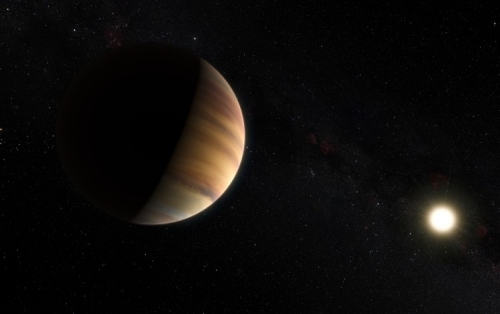
Image: This artist’s view shows the hot Jupiter exoplanet 51 Pegasi b, which orbits a star about 50 light-years from Earth in the constellation of Pegasus. This was the first exoplanet around a normal star to be found, in 1995. Twenty years later this object was also the first exoplanet to be be directly detected spectroscopically in visible light. Credit: ESO/M. Kornmesser/Nick Risinger (skysurvey.org).
The research reduced the 8826 objects on the list of Kepler objects of interest (KOI) down to 129 KOIs by removing known false positives, candidates with orbits of more than 400 days (where fewer than three transits could be observed) and stars that the SOPHIE instrument found too faint to work with. Installed on the 1.93 meter telescope of the Observatory of Haute-Provence, SOPHIE (Spectrographe pour l’Observation des Phénomènes des Intérieurs stellaires et des Exoplanètes) is capable of measuring radial velocities of 2 meters per second.
With a hard 129 KOIs chosen as its defined sample, the team then went to work on the remnant. These KOIs all showed a transit depth between 0.4% and 3% and a period of up to 400 days. The method was to perform a radial velocity follow-up on these candidates using SOPHIE during six observing seasons. The paper describes the result:
…we found that 45 bona-fide planets (30 already known and 15 new ones characterised by our team), 3 sub-stellar companions that are likely brown dwarfs, 63 multiple stellar systems… out of which 48 are eclipsing binaries and 15 are more complex stellar systems. Finally, for 18 objects, we rejected that they are grazing EBs or brown dwarfs, but we could not establish their planetary nature. For these, we were able to put an upper-limit on their mass.
The false positive rate turns out to be significantly higher than previous values, and the paper argues that the absolute number of false positives is expected to grow as we look at planet candidates with a smaller radius. It’s interesting to see in the results that the occurrence rate of ‘hot Jupiters’ is lower by a factor of 2 compared with other surveys. This lower occurrence rate is not found for gas giants with orbital periods longer than 85 days, leading the authors to speculate that there may be mechanisms of ‘hot Jupiter’ formation specific only to them.

Image: Selected population of planet candidates detected by the Kepler Space Telescope. Their transit depth is displayed here as a function of their orbital period. The size of the marker is relative to the magnitude of the host. Credit: Santerne et al.
We always knew that finding exoplanets, much less characterizing them, was an exceedingly fine-grained task, but these results tell us that even the largest planets, and presumably the easiest to detect, present their own set of problems. The importance of radial velocity follow-ups is clear given the numerous sources of noise in the data. The paper goes on to discuss what may be a connection between the density of moderately irradiated giant planets and the metallicity of their host stars, but the authors say that the correlation needs to be confirmed with more planets in this category.
The paper is Santerne et al., “SOPHIE velocimetry of Kepler transit candidates XVII. The physical properties of giant exoplanets within 400 days of period,” accepted at Astronomy & Astrophysics (preprint).



















